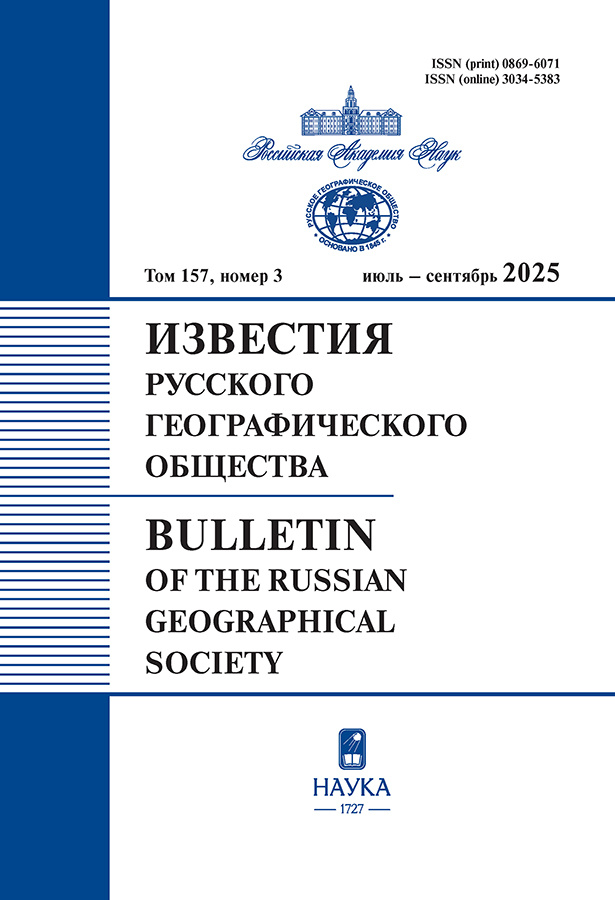Regional differences in the accumulation of produced ferrous metals stocks and scrap metal in the Russian economy
- Authors: Imangulov L.R.1
-
Affiliations:
- Lomonosov Moscow State University
- Issue: Vol 157, No 3 (2025)
- Pages: 451-465
- Section: Articles
- URL: https://journals.eco-vector.com/0869-6071/article/view/691773
- DOI: https://doi.org/10.31857/S0869607125030124
- EDN: https://elibrary.ru/lubzbb
- ID: 691773
Cite item
Full Text
Abstract
The article analyzes regional differences in the accumulation of ferrous metals and scrap metal stock in the Russian economy. The author’s method of assessing the metal stock of Russian regions is based on the statistical study of the regional distribution of ferrous metals in different types sectors of economic activity. The data sources are basic socio-economic indicators of the regions, the size and sectoral structure of the national ferrous metal stock. The results of the assessment revealed a significant regional variation of ferrous metal reserves. The regions of the Urals, Volga and Centre with developed industry and high population have significant reserves of ferrous metals. It was revealed that the distribution of regions by accumulation of ferrous scrap metal is not identical to their distribution in accordance with the stocks of produced ferrous metals. The distribution of regions by accumulation of ferrous scrap metal is not identical to their distribution according to stocks of produced ferrous metals. The deviations are caused by different factors. For example, in metallurgical regions, a more intensive accumulation of scrap metal is associated with the specifics of production processes in the ferrous metallurg. The results of the correlation analysis confirmed the relationship between the metal stock value in 2016 and the volumes of ferrous metal waste and scrap accumulation in 2016–2023. Regions where there is no direct correlation between the analysed indicators were found. The reasons are the peculiarities of economic development of the territories and the methodology of calculating the indicator. In conclusion, the author compared the resource base and the scale of development of scrap collection activities in Russian regions. The author identified cases of inconsistency between the number of scrap collection organisations the resource capabilities of the territories. This highlights the need for further analysis of the development of the recycling industry in conjunction with other factors.
About the authors
L. R. Imangulov
Lomonosov Moscow State University
Email: linar.imangulov.1999@mail.ru
Moscow, Russia
References
- Amosha A.I., Marchenko V.M., Ljashenko V.I. Osobennosti potenciala rynka loma chernyh metallov dlja razvitija metallurgii Rossii i Ukrainy // Nacional’nye interesy: prioritety i bezopasnost’. 2009. № 18. S. 55–71.
- Budanov I.A. Rol’ rynka metalloloma v reshenii resursnyh problem metallurgii // Problemy prognozirovanija. 2002. № 2. S. 43–57.
- Gorjachko M.D., Imangulov L.R. Ocenka optimal’nosti syr’evyh zon predprijatij chernoj metallurgii Rossii v oblasti zakupok metalloloma // Regional’nye issledovanija. 2022. № 2. S. 40–52. https://doi.org/10.5922/1994-5280-2022-2-4
- Zusman L.L. Metallicheskij fond narodnogo hozjajstva SSSR. M.: Metallurgija, 1975. 407 s.
- Kozlov G.I., Rajkov Ju.N. Metallicheskij fond chernyh metallov Rossii (metodika i rezul’taty raschetov) // Jekonomika v promyshlennosti. 2013. № 2. S. 13–17.
- Mazein N.V. Krupnejshie arealy chernoj metallurgii mira: ierarhija i faktory razmeshhenija // Regional’nye issledovanija. 2009. № 2. S. 59–73.
- Rodionova I.A. Geograficheskie osobennosti projavlenija processov migracii proizvodstva v metallurgii mira // Vestn. RUDN. Jekonomika. 1999. № 1. S. 71–82.
- Struktura metallofonda RF s razdeleniem na chernyj i cvetnoj lom : internet-portal marketingovogo agentstva “MegaResearch”. [2008]. URL: https://www.megaresearch.ru/knowledge_library (data obrashhenija: 20.01.2025)
- Tkachev S.A., Gol’m D.A. Transformacija faktorov territorial’noj organizacii chernoj metallurgii v Rossii i za rubezhom // Vestnik KRAGSiU. 2014. № 13. S. 99–104.
- Ugreninov S.V. Funkcionirovanie i vzaimodejstvie regional’nyh rynkov loma i othodov chernyh metallov. Taganrog: Izd-vo ChOU VO TIUiJe, 2020. 96 s.
- Federal’naja sluzhba gosudarstvennoj statistiki: feder. internet-portal. [1999]. URL: https://rosstat.gov.ru (data obrashhenija: 20.01.2025)
- Hrushhev A.T. Geografija promyshlennosti SSSR. M.: Mysl’, 1986. 415 s.
- Drakonakis K., Rostkowski K., Rauch J., Graedel T.E., Gordon R.B. Metal capital sustaining a North American city: Iron and copper in New Haven, CT // Resources, Conservation and Recycling. 2007. Vol. 49. №. 4. P. 406-420. https://doi.org/10.1016/j.resconrec.2006.05.005
- Giarratani F., Gruver G., Richmond C. The US Regional Ferrous Scrap Model. In book: Trade, Networks and Hierarchies. 2002. P. 159–175.
- Graedel T.E., Reck B., Ciacci L., Passarini F. On the Spatial Dimension of the Circular Economy. Resources. 2019. № 8. P. 10. https://doi.org/10.3390/resources8010032
- Gruver G., Giarratani F. Modeling Geographic Ferrous Scrap Markets: Regional Prices and Interregional Transactions in the United States. Journal of Regional Science. 2005. № 2. P. 313–341. https://doi.org/10.1111/j.0022-4146.2005.00373.x
- Hattori R., Horie S., Hsu F., Elvidge C., Matsuno Y. Estimation of in-use steel stock for civil engineering and building using nighttime light images // Resources, Conservation and Recycling. 2013. № 83. P. 1–5. https://doi.org/10.1016/j.resconrec.2013.11.007
- Lyons D., Rice M., Wachal R. Circuits of scrap: Closed loop industrial ecosystems and the geography of US international recyclable material flows 1995–2005. The Geographical Journal. 2009. № 4. https://doi.org/10.1111/j.1475-4959.2009.00341.x
- Metal stocks in society: a scientific synthesis (2010). Report of the UN program UNEP. [Electronic resource]. Access mode: https://www.resourcepanel.org (access date: 06/11/2024)
- Pauliuk S., Wang T., Müller D.B. Steel all over the world: Estimating in-use stocks of iron for 200 countries // Resources, Conservation and Recycling. 2013. Vol. 71. P. 22–30. https://doi.org/10.1016/j.resconrec.2012.11.008
Supplementary files







